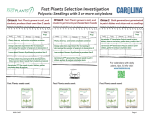Polycots Selection Investigation Calendar Comparison
This PDF document shows three calendars side-by-side for comparing the time and materials needed for three different versions of the Fast Plants Polycot Selection Investigation.
Option A involves Fast Plants grown in soil, and students select for or against polycots, then produce their own Generation 2 seeds to determine the effects of their selection.
Option B involves Fast Plants grown in soil; then students germinate purchased Generation 2 seeds that were produced commercially to increase polycot frequency, and students then collect data and compare polycot frequencies between Generation 1 and 2.
Option C involves Polycot Fast Plants seed lines for both Generation 1 and 2 germinated in Petri dishes to produce data for students to observe firsthand and analyze for evidence of selection effects.
- NGSS.HS.LS4.4 Construct an explanation based on evidence for how natural selection leads to adaptation of populations. [Clarification Statement: Emphasis is on using data to provide evidence for how specific biotic and abiotic differences in ecosystems (such as ranges of seasonal temperature, long-term climate change, acidity, light, geographic barriers, or evolution of other organisms) contribute to a change in gene frequency over time, leading to adaptation of populations.]
- NGSS.MS.LS4.6 Use mathematical representations to support explanations of how natural selection may lead to increases and decreases of specific traits in populations over time. [Clarification Statement: Emphasis is on using mathematical models, probability statements, and proportional reasoning to support explanations of trends in changes to populations over time.] [Assessment Boundary: Assessment does not include Hardy Weinberg calculations.]

Comments